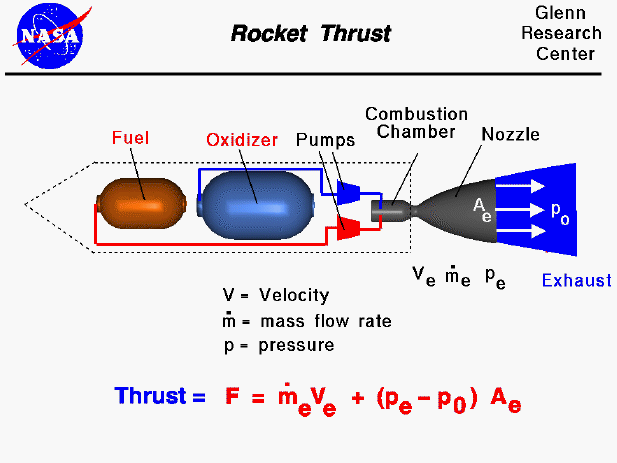

On this slide, we show a schematic of a liquid rocket engine. Rocket engines were used on several high speed aircraft following World War II. In a rocket, stored fuel and stored oxidizer are pumped into a combustion chamber where they are mixed and exploded. The hot exhaust is then passed through a nozzle, which accelerates the flow. The exit velocity is determined by the shape of the rocket nozzle and is supersonic. The exit pressure is set by the nozzle shape as well and will only be equal to free stream pressure at some design condition. We must, therefore, use the longer version of the thrust equation to describe the thrust of the system. If the mass flow is denoted by "m dot", the exit velocity by Ve, the pressure at the exit by pe, the free stream pressure by p0, and the nozzle exit area by Ae, the thrust (F) is given by:
F = m dot * Ve + (pe - p0) * Ae
This thrust equation works for both liquid and solid rocket engines. The mass flow rate through the propulsion system is determined by the nozzle design. You can explore the design and operation of a rocket nozzle with our interactive nozzle simulator program which runs on your browser. Notice that there is no free stream mass times free stream velocity term in the thrust equation because no external air is brought on board. Since the oxidizer is carried on board the rocket, rockets can generate thrust in a vacuum where there is no other source of oxygen. That's why a rocket will work in space, where there is no surrounding air, and a gas turbine or propeller will not work. Jets and propellers rely on the atmosphere to provide the oxygen.
The details of how to mix and burn the fuel and oxidizer are very complex. (It DOES take a rocket scientist to figure it out!) You can learn more about rocket operation by visiting the NASA Glenn K-12 web site on practical rocketry (http://www.lerc.nasa.gov/WWW/K-12/TRC/Rockets/practical_rocketry.html).
Go to...
byTom
Benson
Please send suggestions/corrections to: benson@grc.nasa.gov